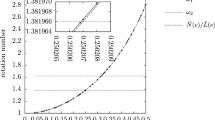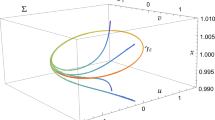Abstract
A new method for rigorously computing orbits of discrete dynamical systems is introduced. High order zonotope enclosures of the orbit are computed, using only matrix algebra. The wrapping effect can be made arbitrarily small by choosing the order high enough. The method is easy to implement and especially suited for parallel computing. It is compared to other well known strategies, and several examples are given.
Similar content being viewed by others
Explore related subjects
Discover the latest articles, news and stories from top researchers in related subjects.References
BarbĂroşie, C.: Reducing the wrapping effect. Computing54, 347–357 (1995).
Corliss, G. F.: Survey of interval algorithms for ordinary differential equations. Appl. Math. Comput.31, 112–120 (1989).
Corliss, G. F.: Guaranteed error bounds for ordinary differential equations. VI-th SERC Numerical Analysis Summer School, Leicester University, 1994. Available at ftp://interval.usl.edu/pub/interval_math/bibliographies/surv_ode.bib.
Davey, D. P., Stewart, N. F.: Guaranteed error bounds for the initial value problem using polytope arithmetic. BIT16, 257–268 (1976).
Gambill, T. N., Skeel, R. D.: Logarithmic reduction of the wrapping effect with application to ordinary differential equations. SIAM J. Numer. Anal.25, 153–162 (1988).
Guderley, K. G., Keller, C. L.: A basic theorem in the computation of ellipsoidal error bounds. Numer. Math.19, 218–229 (1972).
Jackson, L. W.: Interval arithmetic error-bounding algorithms. SIAM J. Numer. Anal.12, 223–238 (1975).
Kuhn, W.: Rigorous and reasonable error bounds for the numerical solution of dynamical systems. PhD thesis, Georgia Institute of Technology, Atlanta, 1997.
Lohner, R.: Einschließung der Lösung gewöhnlicher Anfangs- und Randwertaufgaben und Anwendungen. PhD thesis, University of Karlsruhe, 1988. Dissertation.
Moore, R. E.: Interval Analysis. Prentice-Hall, Englewood Cliffs, NJ, 1966.
Neumaier, A.: Interval methods for systems of equations. Cambridge University Press, 1990.
Neumaier, A.: The wrapping effect, ellipsoid arithmetic, stability and confidence regions. Computing [Suppl]9, 175–190 (1993).
Nickel, K. L. E.: Using interval methods for the numerical solution of ODEs. Z. Angew. Math. Mech.66, 513–523 (1986).
Rihm, R.: Interval methods for initial value problems in ODEs. In: Topics in validated computations (Herzberger, J., ed.). New York: Elsevier Science B.V., 1994.
Schneider, R., Weil, W.: Zonoids and related topics. In: Convexity and its Applications (Gruber, P. M., Wills, J. M., eds.), pp. 296–317. Basel: Birkhauser, 1986.
Ziegler, G. M.: Lectures on polytopes. Berlin Heidelberg, New York Tokyo, Springer, 1995.
Author information
Authors and Affiliations
Rights and permissions
About this article
Cite this article
Kühn, W. Rigorously computed orbits of dynamical systems without the wrapping effect. Computing 61, 47–67 (1998). https://doi.org/10.1007/BF02684450
Received:
Revised:
Issue Date:
DOI: https://doi.org/10.1007/BF02684450




